Introduction
The Picture Exchange Communication System (PECS) is a transformative augmentative and alternative communication (AAC) approach designed to support individuals with autism in expressing their needs, desires, and thoughts. Developed in the 1980s, PECS uses visual symbols to facilitate effective communication, making it an essential tool for non-speaking children and those with complex communication needs. By enabling these individuals to exchange pictures for words, PECS helps bridge communication gaps, foster relationships, and enhance participation in academic settings.
This article delves into the foundational aspects of PECS, its structured phases, and the collaborative efforts required for its implementation. It highlights the significant role of speech-language pathologists, educators, and family members in supporting children’s communication journeys. Moreover, it explores the myriad benefits of PECS, from reducing frustration and challenging behaviors to promoting social skills and independence.
Additionally, the article addresses practical implementation strategies, challenges, and long-term benefits, emphasizing the importance of early intervention and ongoing support.
By understanding and utilizing PECS, caregivers and educators can empower children with autism, providing them with the tools needed for meaningful interactions and improved quality of life.
What is PECS?
'The Picture Exchange System is a crucial augmentative and alternative method, specifically created to assist individuals with autism in their expressive efforts.'. 'Created in the 1980s, this system utilizes visual symbols, allowing individuals to swap images for words, thereby promoting efficient communication of wants, desires, and ideas. This system is especially advantageous for individuals with intricate expression requirements, who may find it challenging to use speech in everyday interactions.
For non-verbal youngsters, access to AAC methods such as picture exchange communication systems is crucial not only for articulating their desires and preferences but also for building connections and engaging in educational activities. The significance of such systems is highlighted by the fact that kids with autism often need customized ways to connect and fill their interaction gaps. In educational settings, paraeducators often collaborate with students to assist with their expressive requirements, emphasizing the essential role of PECS in learning environments.
Furthermore, progress in research and training initiatives, like the NCSER-funded POWR System created by Dr. Sarah Douglas at Michigan State University, seeks to enhance the communication abilities of children with complex communication requirements. These initiatives underscore the ongoing efforts to refine and enhance AAC interventions, ensuring they meet the dynamic needs of individuals with autism throughout their lives. 'The incorporation of picture exchange communication systems into daily routines not only fosters meaningful interactions but also promotes social participation and independence, ultimately improving the quality of life for individuals with autism.'.
How PECS Works
PECS (Picture Exchange Communication System) employs a visual-based method to assist in expressing needs for individuals with autism and other developmental disabilities. This structured system begins by teaching users to exchange a picture of a desired item with a communication partner to receive that item. Over time, users progress to constructing sentences using multiple pictures, thereby enhancing their ability to communicate more complex ideas and needs.
The execution of this communication system involves various key participants, including speech-language pathologists (SLPs), teachers, paraeducators, and family members. These interaction partners play an essential role in aiding the young individual’s use of Picture Exchange Communication System, ensuring regular use both at home and in educational environments. A recent grant from the Institute of Education Sciences (IES) facilitated the development of a professional development and training intervention for school-based SLPs. This initiative aims to assist family members in implementing interaction strategies, emphasizing the importance of a collaborative approach.
Research highlights the importance of augmentative and alternative methods such as PECS for non-verbal individuals. These systems allow young individuals to communicate their requirements, build relationships, and engage in educational activities. Dr. Sarah Douglas from Michigan State University has been actively developing the POWR system, an online training program designed to improve the interaction abilities of young individuals with complex communication needs. This program highlights the significance of integrating AAC strategies into daily routines to support meaningful interactions and improve social skills.
The effectiveness of picture exchange communication systems and similar AAC interventions is supported by data illustrating positive outcomes in responsive and engaging parent–child interactions. These interactions are linked to enhanced involvement and interaction abilities in youngsters with autism. By nurturing a helpful atmosphere through the application of alternative visual supports, caregivers and educators can assist young individuals in cultivating a stronger sense of autonomy in their expression.
Benefits of PECS for Autism
The advantages of the Picture Exchange Communication method for individuals with autism are numerous. By offering a visual method for interaction, this system tackles the intricate expressive requirements frequently seen in children with autism. This system improves interaction abilities, which is vital for articulating desires and requirements, thus diminishing frustration and difficult behaviors that arise from a lack of effective expression. When individuals with autism can express themselves more clearly, their independence grows, opening up opportunities for meaningful social interactions.
This system not only enhances interaction but also aids in the growth of social abilities. For example, in educational environments, paraeducators frequently collaborate with students to assist with their interaction requirements using systems such as Picture Exchange. An example of such assistance includes the POWR System, an online training program created by Dr. Sarah Douglas to enhance interaction abilities in children with complex communication needs. This program provides paraeducators and supervising teachers with the tools necessary to implement the Picture Exchange Communication System effectively.
Additionally, studies show that developmental strategies, such as picture exchange systems, greatly enhance social interaction in exchanges with caregivers. These interventions tackle fundamental issues related to autism, especially social interaction difficulties. As young individuals with autism participate more with their surroundings through picture exchange communication systems, they experience enhanced social interactions and cultivate better relationships.
Statistics show that up to 70% of individuals with autism struggle with issues like anxiety and challenging behaviors. By promoting improved interactions and social abilities through picture exchange systems, these difficulties can be alleviated, resulting in a more favorable developmental path. Incorporating picture exchange systems into everyday activities can enable children with autism, giving them a stronger sense of control in their interactions and improving their overall quality of life.
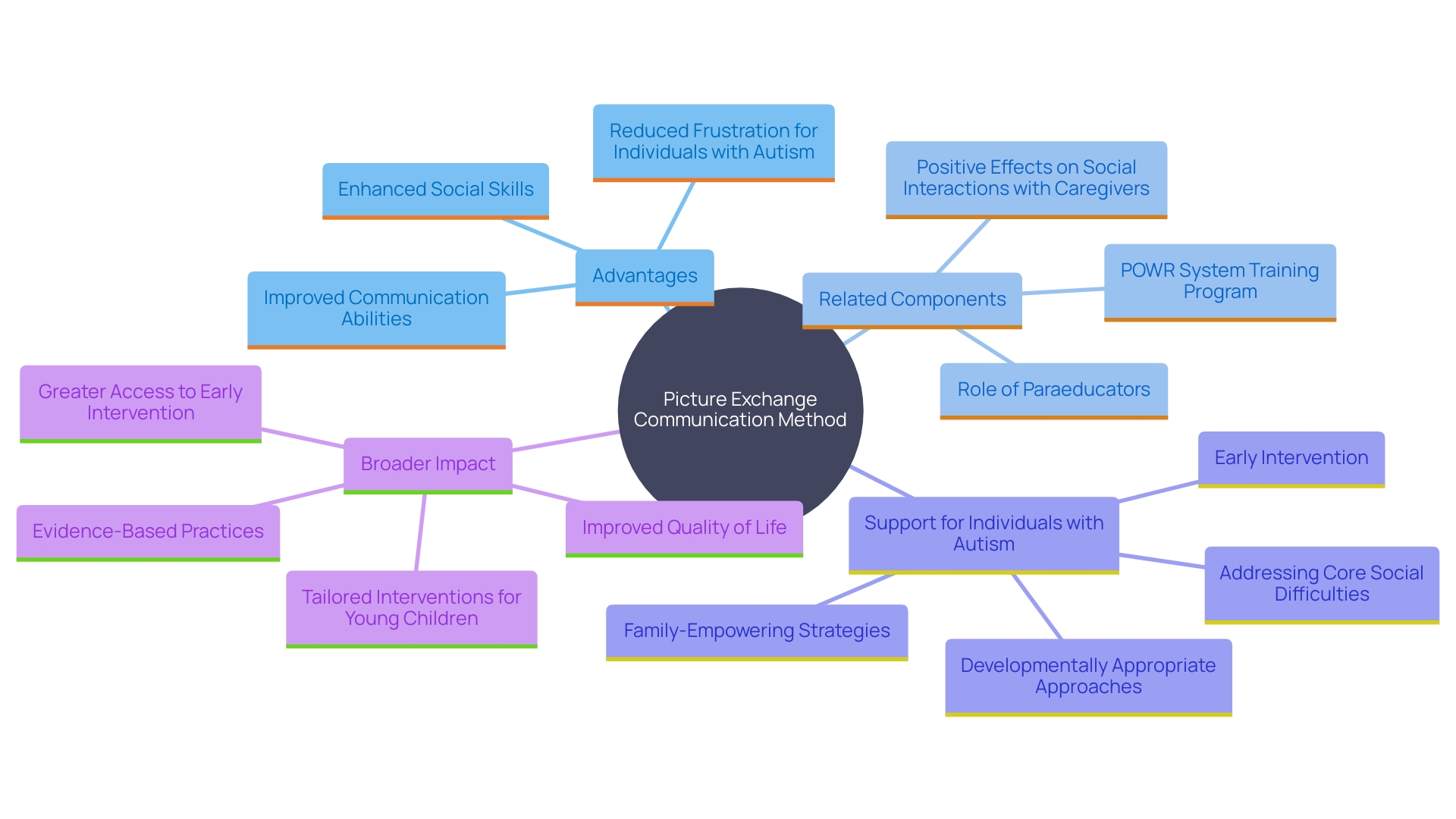
Phases of PECS
The Picture Exchange Communication System (PECS) is methodically divided into six phases, each progressively enhancing the user’s ability to communicate. The initial phase is crucial as it teaches the individual to exchange a single picture for a desired item, laying the foundation for meaningful interaction. As the user progresses through the phases, more intricate interaction skills are introduced. This encompasses building sentence frameworks and encouraging unplanned interaction, which are crucial for articulating subtle ideas and requirements.
Research underscores the importance of these structured phases. For instance, joint attention—a crucial intervention aim—centers on social interaction rather than merely functional interaction, which is frequently employed to satisfy immediate requirements. This distinction is pivotal for individuals with autism as joint attention requires considering the partner’s interests and perspectives, a known challenge in autism. Incorporating these phases into early interventions can leverage the unique parent-child relationship to enhance social learning and engagement.
Additionally, speech-language pathologists (SLPs) and educators play significant roles in supporting and implementing these interaction strategies. Recent advancements include professional development programs aimed at training school-based SLPs to assist family members in utilizing these techniques effectively. These initiatives emphasize the teamwork required to assist individuals with intricate expression needs.
The Interagency Autism Coordinating Committee (IACC) has also emphasized the importance of early screening and intervention in their 2022 Summary of Advances in Autism Research. Their discoveries indicate that timely and steady use of techniques such as picture exchange can greatly enhance social interaction, language growth, and overall quality of life for individuals with autism. By systematically progressing through the phases, individuals can cultivate strong skills that give them increased independence and a more powerful presence in their interactions.
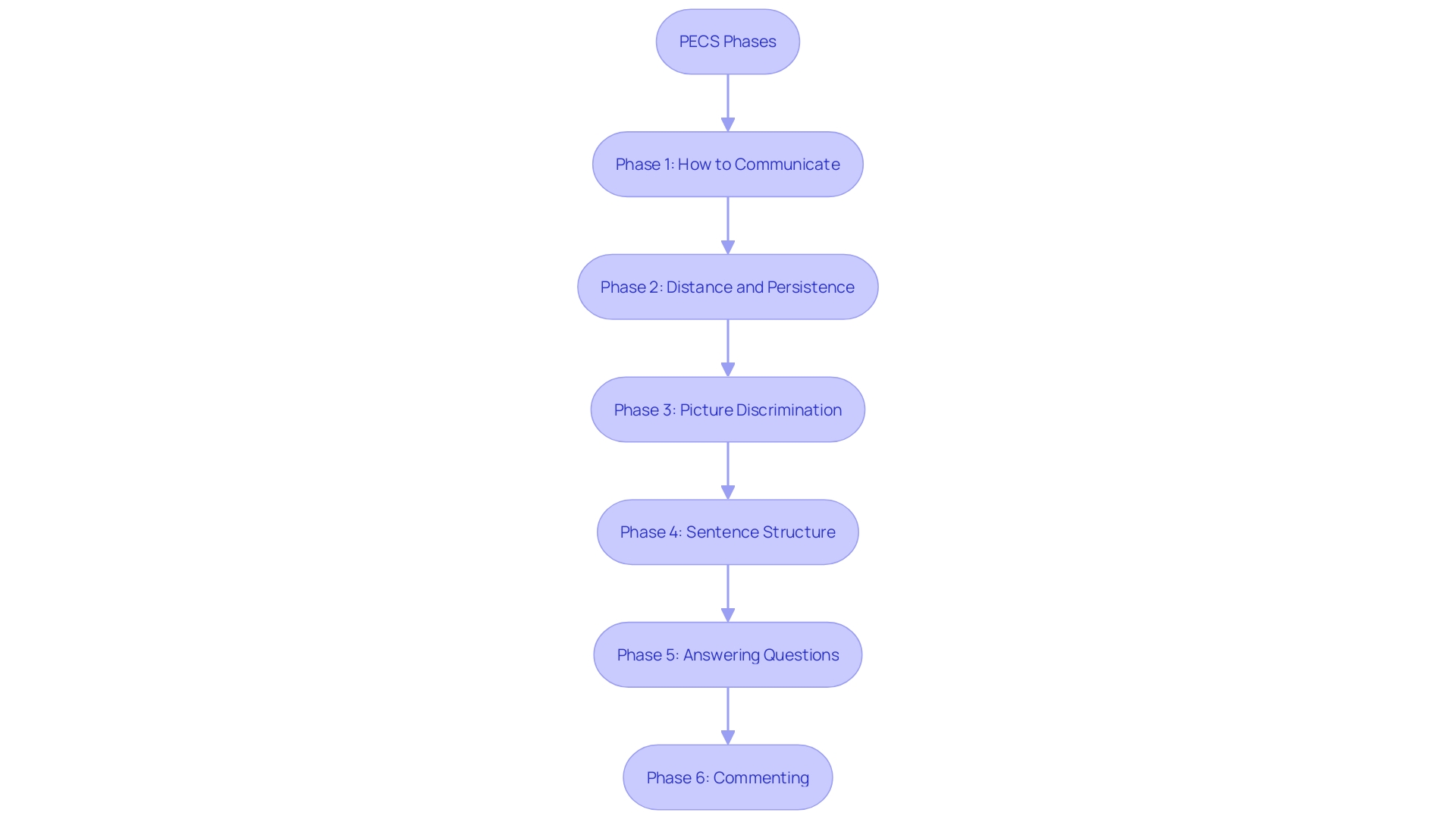
Practical Implementation of PECS
Establishing a system involves creating a tailored visual book or board filled with images that represent different items, actions, and feelings. This system supports non-verbal individuals by providing them with a way to communicate effectively. Parents, educators, and therapists can collaborate to implement PECS in everyday environments, ensuring that the individual has ample opportunities to practice and strengthen their expressive abilities during daily tasks. 'This cooperative method not only improves the young person's capacity to convey their wants and aspirations but also encourages significant exchanges that are vital for their social growth.'. For instance, Dr. Sarah Douglas has been developing the POWR System to enhance interaction abilities of youth with complex needs, emphasizing the significance of engaging various stakeholders in the process. By incorporating visual communication systems into daily routines, caregivers can create a supportive environment that promotes the child's independence and confidence in their communication abilities.
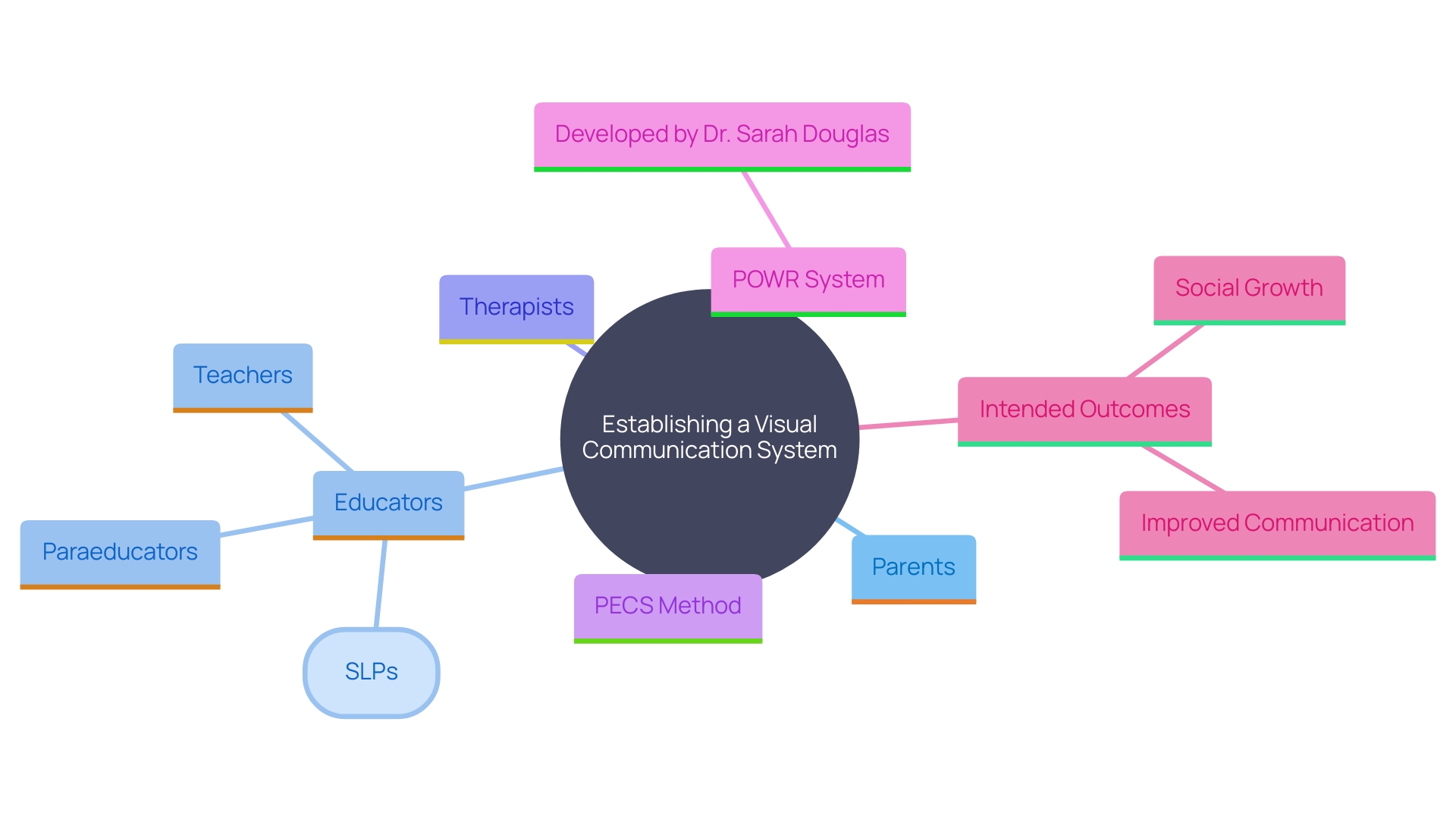
Challenges and Solutions with PECS
While picture exchange communication systems can be incredibly effective, some challenges may arise. Initially, individuals may struggle with the concept of exchanging pictures or may become frustrated if they do not receive the expected item. Consistent practice, patience, and positive reinforcement are essential to overcome these challenges.
Adapting the system to the individual's preferences can significantly increase engagement and motivation. For example, incorporating favorite items or preferred activities into the PECS system can make the process more appealing. Furthermore, involving essential partners in dialogue such as siblings, parents, teachers, and speech-language pathologists (SLPs) can provide a more comprehensive support system. Research shows that training and engaging these partners can significantly improve the effectiveness of messaging strategies.
In educational environments, paraeducators often assist students with intricate interaction requirements. 'Initiatives such as the POWR System, created by Dr. Sarah Douglas, have demonstrated encouraging outcomes in enhancing the expressive abilities of youngsters with intricate interaction requirements by offering training for paraeducators and their supervising instructors. Such interventions not only assist the child's immediate expression requirements but also aid in the development of long-term expression abilities.
By combining these approaches and ensuring a nurturing atmosphere, this method can become a powerful tool for improving interaction and fostering independence among individuals with autism.
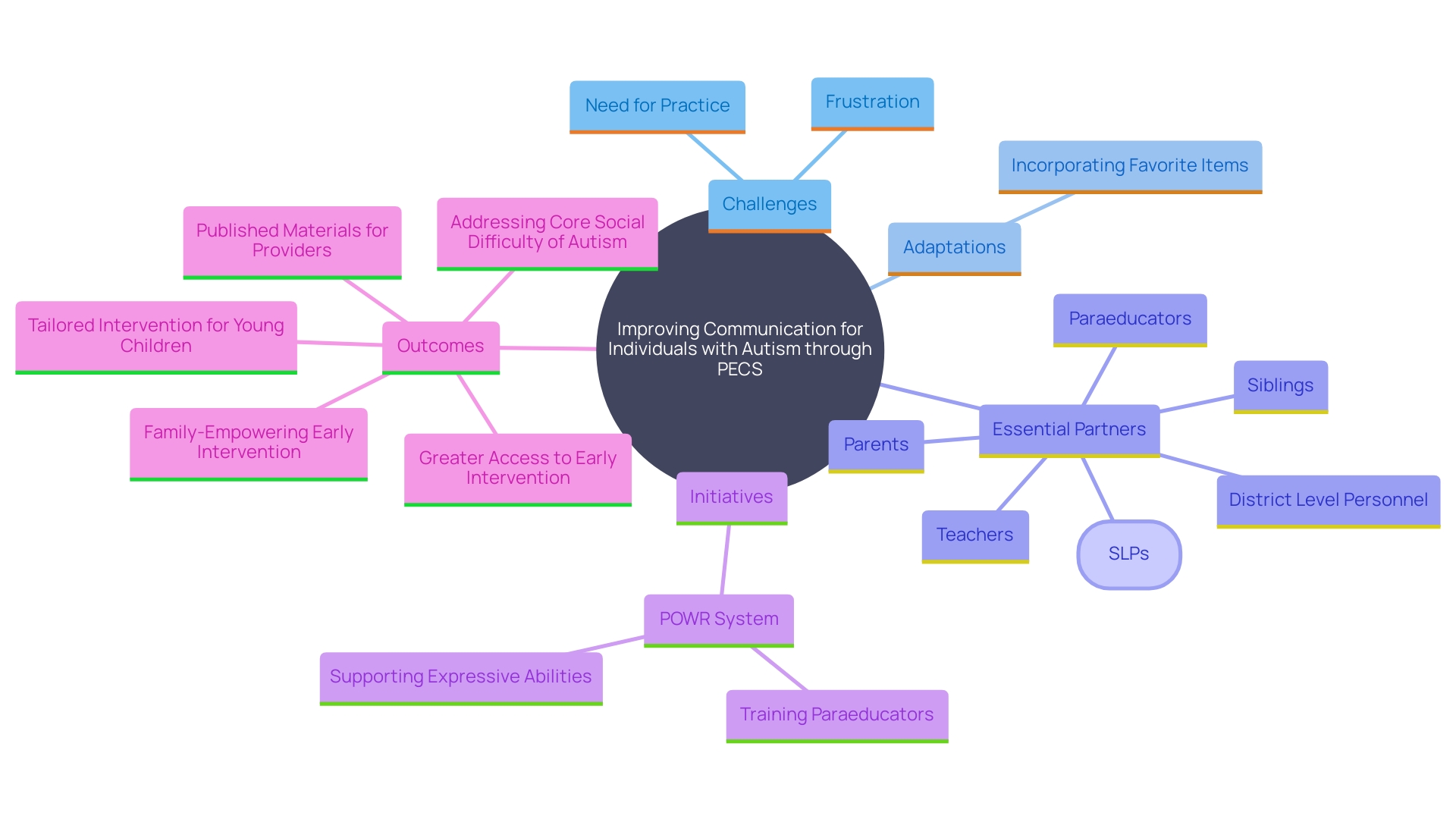
Impact of PECS on Communication
The impact of the Picture Exchange Communication System (PECS) on expressing ideas is transformative, providing users with a profound improvement in their ability to convey thoughts and needs. This enhanced ability not only improves their quality of life but also fosters a sense of autonomy and confidence in social interactions, significantly reducing the anxiety associated with interaction barriers.
Research has highlighted the importance of early intervention in addressing the core social difficulties of autism. For instance, developmental interventions have been shown to enhance social interaction, particularly in exchanges with caregivers, which is crucial for children with autism. This corresponds with the objective of the system, which is to create a strong means of interaction that fosters autonomy and meaningful exchange as individual aims and requirements develop.
The importance of augmentative and alternative methods, such as picture exchange systems, cannot be emphasized enough. Over five million individuals in the US, who cannot rely on spoken language, benefit from AAC systems to participate in daily activities, develop relationships, and engage in academic instruction. This is especially relevant in educational environments, where paraeducators play an essential role in assisting the interaction requirements of youngsters with intricate expression difficulties.
Practical uses of this communication system have demonstrated encouraging outcomes. For instance, early support initiatives customized for the requirements of very young children facing social interaction difficulties have proven successful in promoting family-empowering approaches. These interventions are not only feasible but also yield positive outcomes for toddlers showing early signs of autism.
To summarize, the application of AAC systems similar to those mentioned is essential in assisting the expressive needs of individuals with autism, improving their social interactions, and fostering a greater sense of independence and well-being.
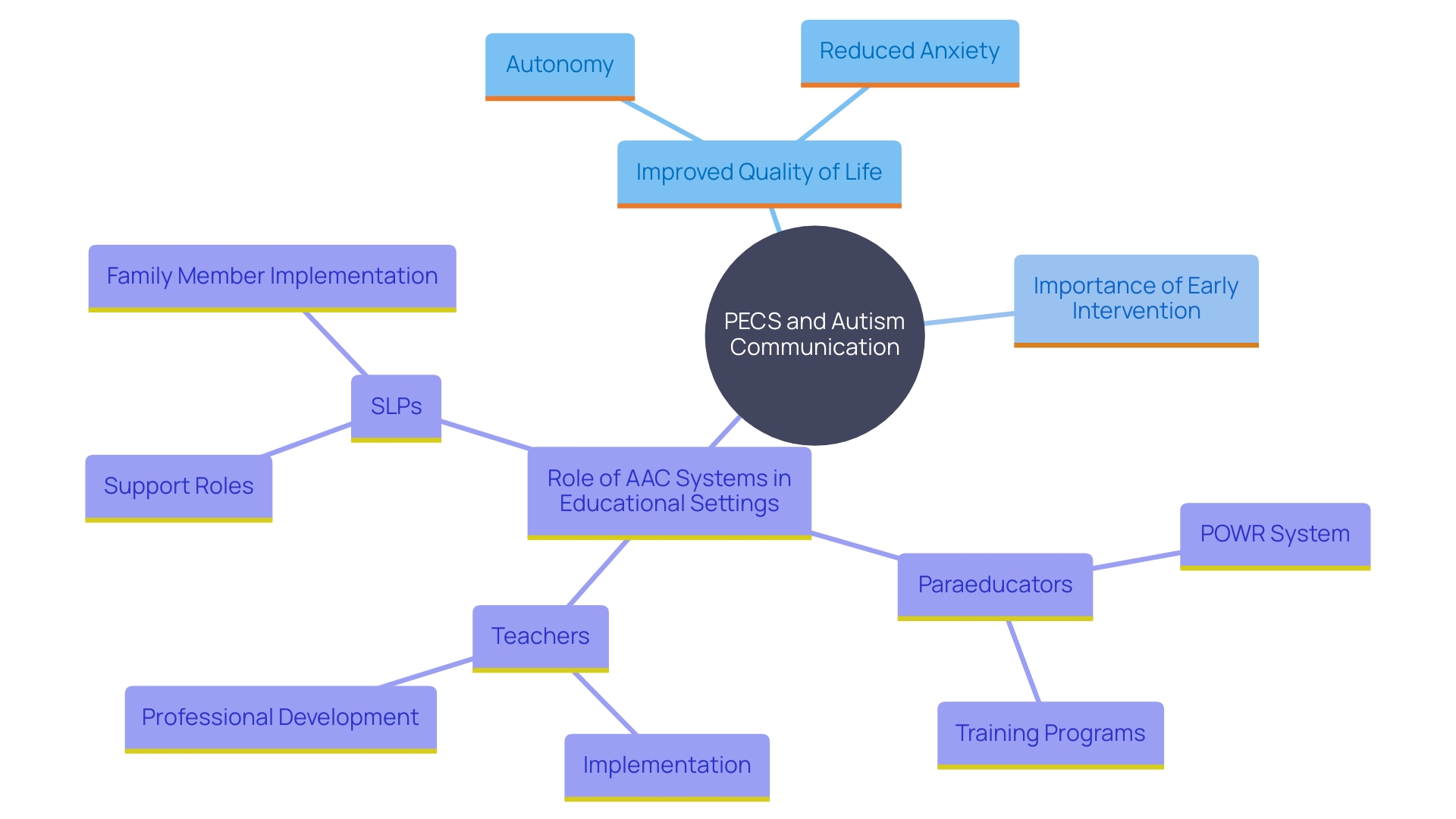
Promoting Independence and Self-Expression with PECS
PECS not only assists in instant interaction but also encourages long-term self-sufficiency. By providing a structured yet adaptable interaction framework, individuals with autism can navigate their daily exchanges with increased confidence and autonomy. As they become more adept at using the system, they gain greater control over their interactions and choices, fostering a sense of empowerment that significantly improves self-expression. This empowerment enables individuals to share their thoughts, preferences, and emotions more freely, leading to richer and more meaningful social interactions. Dan Harris, an advocate for autism acceptance, highlighted the transformative impact of such tools when his non-speaking son began using picture boards to express himself, calling it a 'life-changing' moment. Devices such as picture exchange systems and other supportive and substitute interaction frameworks are essential in unlocking the potential of non-speaking individuals, enabling them to engage fully in educational environments and beyond.
Long-term Benefits of PECS
The long-term advantages of applying the Picture Exchange System extend well beyond immediate interaction enhancements. Research shows that many individuals who use PECS can develop verbal skills over time. This progress is not just limited to speech; the confidence gained from effective interaction can significantly enhance social relationships, boost academic performance, and contribute to overall personal development.
Reflect on the significant effect of augmentative and alternative interaction (AAC) systems on youngsters with intricate expressive requirements, including those with autism. AAC systems, which range from low-tech solutions like picture cards to high-tech speech-generating devices, offer these individuals a vital means to express their needs and participate more fully in their environments. For example, in academic environments, paraeducators frequently collaborate with these students to assist their interaction, with initiatives like Dr. Sarah Douglas's POWR System training program for paraeducators showing significant advancements in youngsters’ interaction abilities.
Moreover, the benefits of early intervention cannot be overstated. Evidence indicates that developmental interventions not only enhance core challenges linked to autism, especially social interaction difficulties, but also promote meaningful exchanges with caregivers. By addressing the unique interaction needs of autistic youngsters early, these interventions establish a solid basis for long-term success. This foundation is essential, as up to one-third of autistic individuals cannot communicate effectively using speech alone, even after years of intervention.
Statistics further underscore the urgency of early and effective communication support. Up to 70% of autistic youth struggle with additional challenges such as anxiety, mood difficulties, and behavioral issues that can affect their development and daily interactions. By incorporating picture exchange communication systems and other AAC methods into their routines, these individuals are better prepared to navigate social environments, build connections, and attain academic success.
In summary, the implementation of PECS and other AAC systems not only addresses immediate interaction barriers but also paves the way for broader developmental benefits. Through structured support and early intervention, children with complex communication needs can achieve significant milestones in their personal and academic lives.
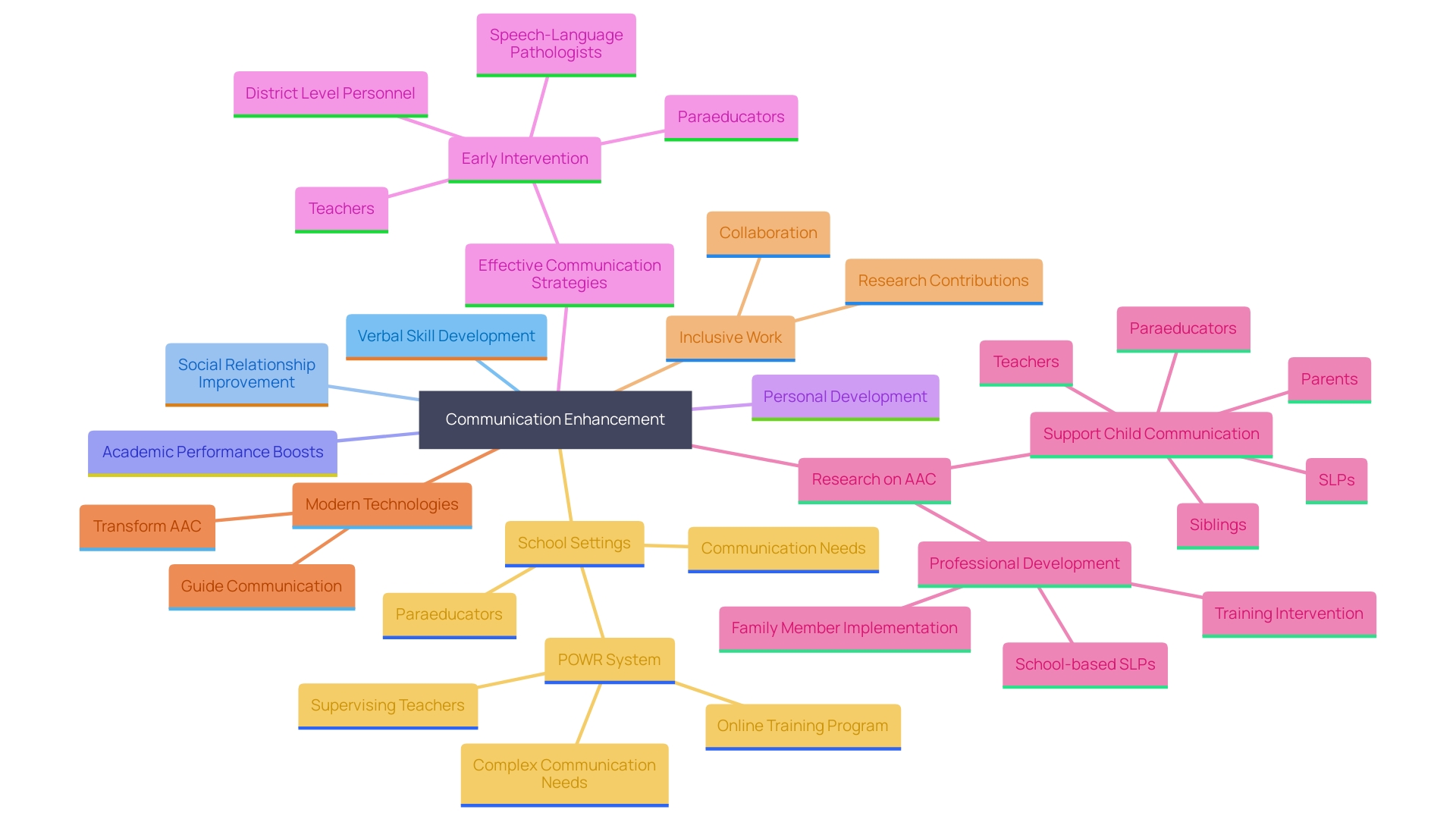
Conclusion
The Picture Exchange Communication System (PECS) serves as a vital lifeline for individuals with autism, facilitating effective communication through a structured, visual approach. By enabling users to exchange pictures for words, PECS not only addresses immediate communication needs but also fosters independence, social skills, and emotional expression. This comprehensive system empowers non-speaking children to articulate their desires and thoughts, significantly reducing frustration and enhancing their quality of life.
Implementing PECS requires a collaborative effort among caregivers, educators, and speech-language pathologists. The structured phases of PECS guide users from basic exchanges to more complex sentence constructions, ensuring a gradual and supportive learning process. With dedicated involvement from communication partners and the integration of personalized strategies, children can thrive in both home and educational settings.
The long-term benefits of PECS extend far beyond immediate communication improvements. Research has shown that early intervention utilizing PECS can lead to the development of verbal communication skills, improved social relationships, and academic success. By addressing the unique challenges faced by individuals with autism, PECS not only enhances communication but also lays a strong foundation for meaningful interactions and personal growth.
In summary, the implementation of PECS is crucial for supporting individuals with autism in their communication journeys. By harnessing the power of visual communication, caregivers and educators can empower children to engage more fully in their environments, fostering a sense of agency and enhancing their overall well-being.




